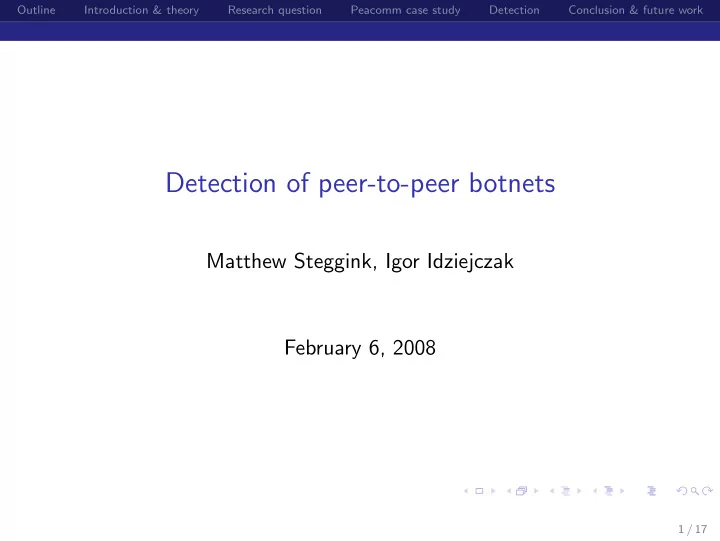

Outline Introduction & theory Research question Peacomm case study Detection Conclusion & future work Detection of peer-to-peer botnets Matthew Steggink, Igor Idziejczak February 6, 2008 1 / 17
Outline Introduction & theory Research question Peacomm case study Detection Conclusion & future work Introduction & theory Research question Peacomm case study Detection Conclusion & future work 2 / 17
Outline Introduction & theory Research question Peacomm case study Detection Conclusion & future work Peer-to-peer botnets ◮ What are botnets . . . and peer-to-peer botnets? ◮ What’s the purpose of bots and botnets? 3 / 17
Outline Introduction & theory Research question Peacomm case study Detection Conclusion & future work Botnet topology 4 / 17
Outline Introduction & theory Research question Peacomm case study Detection Conclusion & future work Research question? in cooperation with SURFnet Detection of peer-to-peer botnets ◮ Why this research ◮ Goal of this research ◮ Previous work . . . 5 / 17
Outline Introduction & theory Research question Peacomm case study Detection Conclusion & future work Peacomm Peacomm ◮ What is Peacomm ◮ DHT: Usage of the Overnet protocol 6 / 17
Outline Introduction & theory Research question Peacomm case study Detection Conclusion & future work How do users get infected? 7 / 17
Outline Introduction & theory Research question Peacomm case study Detection Conclusion & future work Peacomm experimental setup ◮ Peer to peer botnet study ◮ Test environment ◮ Experimenting (CW Sandbox, PerilEyez, Rootkit Unhooker, Wireshark) 8 / 17
Outline Introduction & theory Research question Peacomm case study Detection Conclusion & future work Infection ◮ Executable copy (noskrnl.exe) ◮ Time configuration ◮ Initial peer list (noskrnl.config) ◮ Creates a rule in the Windows Firewall ◮ Rootkit noskrnl.sys 9 / 17
Outline Introduction & theory Research question Peacomm case study Detection Conclusion & future work Secondary injections ◮ Duplicate on the desktop ◮ Update malware through TCP connection ◮ Updates peer list and downloads spam message 10 / 17
Outline Introduction & theory Research question Peacomm case study Detection Conclusion & future work Network analysis UDP ◮ Very noisy: 55 % ◮ Always same high numbered port (different on every host) ◮ Packet length (40-79): 98 %, in total: 51 % 11 / 17
Outline Introduction & theory Research question Peacomm case study Detection Conclusion & future work Network analysis SMTP ◮ 5 % of total traffic → < 0,5% [1] ◮ 33 packets / second ipoque.com, Internet Study 2007 , August - September 2007 12 / 17
Outline Introduction & theory Research question Peacomm case study Detection Conclusion & future work Network analysis MX queries ◮ 1 % of total traffic ◮ 4 packets / second → isolated case? ◮ Host MX queries are suspicious 13 / 17
Outline Introduction & theory Research question Peacomm case study Detection Conclusion & future work Detection ◮ Protocol traffic ◮ SMTP ◮ MX queries ◮ Connection 14 / 17
Outline Introduction & theory Research question Peacomm case study Detection Conclusion & future work Detection Figure: Comparison between all traffic (black), Peacomm traffic (red) and other traffic (blue) (generated with Wireshark) 15 / 17
Outline Introduction & theory Research question Peacomm case study Detection Conclusion & future work Conclusion & future work ◮ Unique characteristics ◮ Hard to predict the future? ◮ Future Peacomm developments: less noisy, what now? ◮ New bots in the future: Agobot? 16 / 17
Outline Introduction & theory Research question Peacomm case study Detection Conclusion & future work Questions? ◮ Matthew Steggink: matthew.steggink@os3.nl ◮ Igor Idziejczak: igor.idziejczak@os3.nl 17 / 17
Recommend
More recommend